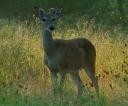White-tailed deer shed their antlers every year prior to the re-growth of new ones. It may surprise you to find out that the entire shedding process takes only two to three weeks to complete, and of course the re-growth phase takes place over the summer up into very early fall. Bucks have antlers throughout spring, summer, and most of the winter, but shed them sometime between January and April (depending upon the animal and latitude), after the rutting season comes to an end. A buck can carry-on without antlers at this time of year because they do not need to fight-off other bucks for territory and does.
Deer antlers differ from the hollow horns of cattle in that they comprise solid bone tissue with a honeycombed structure. Pedicles, the skin-covered nubs protruding from a buck’s skull, serve as a base for antler growth and support the deer’s antlers. However, keep in mind that the pedicles are permanent fixtures on the deer’s forehead, and are the point at which antlers separate from the deer each year.
During the first 8 to 9-months, the pedicles grow and begin to appear on a buck fawn‘s forehead (nubbin buck). Then, the buck actually begins antler growth as a yearling buck (first set of antlers). Each year the buck will go through the antler growing process and shed its antlers. As the deer matures, the antlers typically increase in mass, beam length, and point length. They also will add points in many cases, but not always.
During growth, antlers are covered with a sensitive skin commonly referred to as “velvet.” This velvet is filled with blood vessels that constantly feed the antlers the vitamins and the minerals necessary for bone building. Antler growth demands a lot of vitamins, minerals, protein, and energy, so adequate native forage or supplemental feed must be available to meet these requirements for maximum antler growth.
Antler growth can range from two to four months depending upon the individual buck. After this time, a hardened ring forms at the base of the antlers (burr) that shuts off blood flow to the velvet-covered antlers. As a result, the velvet deteriorates, dries up, and falls off, often assisted by the white-tailed buck, which rubs his antlers against tree bark.
At this point, the antler growing cycle is complete, the buck will prepare for the rut, and the shedding cycle will resume after the fall and winter breeding season. So now is the time to get out and look for those trophy sheds before the rodents eat them away!




No comments:
Post a Comment